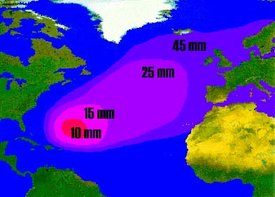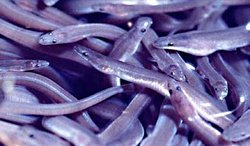Eel life history
|
|
Leptouk.jpg
The eel is a long, thin bony fish of the order Anguilliformes. Because fishermen never caught anything they recognized as eel young, the life history of the eel was a mystery for a very long period of scientific history, and even now there are many unanswered questions.
The European eel (Anguilla anguilla) was the one most familiar to Western scientists, beginning with Aristotle who did the first known research on eels. He stated that they are born of "earth worms", which emerged from the mud with no fertilization needed — they grew from the "guts of wet soil". For a long time, nobody could prove Aristotle wrong. Later scientists believed that the eelpout Zoarces viviparus was the "Mother of Eels" (the translation of the German name "Aalmutter").
In 1777, the Italian Carlo Mondini found the creature's gonads and proved that eels are fish.
Until 1893, larval eels — a transparent, leaflike two-inch (five cm) creature of the open ocean — was considered a separate species, Leptocephalus brevirostris (from the Greek leptocephalus meaning "thin- or flat-head"). But Italian zoologist Giovanni Batista Grassi observed the transformation of a Leptocephalus into a round glasseel in the Mediterranean Sea, and French zoologist Yves Delage proved in a laboratory in Roscoff that both leptocephalus and eels were the same species. Despite this discovery, the name leptocephalus is still used for larval eel.
| Contents |
Search for the spawning grounds
Danish professor Johannes Schmidt, from 1904 onwards, directed many expeditions in the Mediterranean Sea and the North Atlantic, largely financed by the Carlsberg Foundation. He postulated from the similarity of all leptocephali he found that they all must originate from the same parent species. The further into the Atlantic Ocean he propelled research ships, the smaller the leptocephali he caught. Finally, in 1922, he ended up south of Bermuda in the Sargasso Sea where he succeeded in catching the smallest eel-larvae ever seen.
However, Schmidt was unable to observe the spawning directly, nor did he find ready-to-spawn adults. From the size distribution, Schmidt formulated this part of the life history of the eel:
The larvae of European eels travel with the Gulf Stream across the ocean and, after three years, reach England at a size of 45 mm. The common name for this stage is glasseel, based on the transparency of the body. One famous place for large-scale collection of glasseels (for deli-food and stocking) is Epney at the Severn in England. They migrate up rivers, overcoming all sorts of natural challenges -- sometimes by piling up their bodies by the tens of thousands to climb over obstacles -- and they reach even the smallest of creeks (short glasseel migration video).
Glasseelskils.jpg
They can wind themselves over wet grass and dig through wet sand underground for 30 miles to reach upstream headwaters and ponds, colonising the continent. In fresh water they develop pigmentation, turn into elvers (young eels) and feed on creatures like small crustaceans, worms and insects. They grow up in 10 or 14 years to a length of 60 to 80 cm. In this stage they are now called yellow eels because of their golden pigmentation.
Then in July their instinct drives them back towards the seas, crossing even wet grasslands at night to reach the proper rivers. Eel migration out of the Baltic Sea through the Danish belts was the basis of traditional fisheries with characteristic trapnets (Bundgarn).
Whether the adults can ever make the 6,000 km (4,000 mile) open ocean journey back to their spawning grounds north of the Antilles, Haiti, and Puerto Rico remained unknown. By the time they leave the continent their gut dissolves, so they have to rely on stored energy alone. The body undergoes other dramatic changes as well: the eyes start to grow, the eye pigments change for optimal vision in dim blue clear ocean light, and the sides of their bodies turn silvery, best suited to be as invisible as possible during the long open ocean cruise ahead and past many waiting predators. These migrating eels are often called "Silver Eel" or "Big Eyes".
The German fisheries biologist Friedrich Wilhelm Tesch, an eel expert and author of the book "The Eel" (ISBN 0632063890), equipped many expeditions with high-tech instrumentation to follow eel migration, first down the Baltic, then along the coasts of Norway and England, but finally lost the transmitter signals at the continental shelf when the batteries ran out.
He — like Schmidt — kept on trying to persuade sponsors to give more funding for expeditions. His proposal was to release fifty Silver Eels from Danish waters with probes that will detach from the eels each second day, float up and broadcast position, depth and temperature to satellite receivers, possibly jointly with an equivalent release experiment from the countries of the western coast of the Atlantic. However, the experiments have not yet been performed.
Today our knowledge on the fate of the eels once they leave the continental shelf is based on three eels found in the stomachs of deep sea fish, a whale caught off Ireland and off the Azores and some experiments on fife eels.
Rostratamuk.jpg
There is another Atlantic Eel species: the American eel, Anguilla rostrata. First it was believed European and American eels were of the same origin due to their similar appearance and behavior, but genetic work has distinguished the two species.
The spawning grounds for the two species are believed to be very close together, however, with rostrata probably more westward than anguilla, maybe some even within the Gulf of Mexico. These leptocephali exit the Gulf Stream earlier and reach east coast waterways between February and late April at an age of one year and a length of about 60 mm.
Decline of the glasseels
No one yet knows the reasons, but beginning in the mid-1980s, the leptocephalus and glasseel arrival in the spring dropped drastically — in Germany to 10% and in France to 14% of their previous levels — from even conservative estimates. Data from Maine and other North American coasts showed similar declines, although not as drastic.
In 1997 European demand for eels could not be met for the first time ever, and dealers from Asia bought all they could grab. The traditional European stocking programs could not compete any longer: each week the price for a kilogram of glasseel went up another $30. Even before the '97 generation hit the coasts of Europe, dealers from China alone placed advance orders for more than 250,000 kg, some bidding more than $1,100 per kg.
The demand for adult eels has continued to grow, as of 2003. Germany imported more than $50 million worth of eels in 2002. In Europe 25 million kg are consumed each year, but in Japan alone more than 100 million kg were consumed in 1996. As the European eels become less available, worldwide interest in American eels has increased dramatically.
New high-tech eel aquaculture plants are appearing in Asia with detrimental effects on the native Japanese eel, Anguilla japonica. Traditional eel aquaculture operations rely on wild-caught elvers, but experimental hormone treatments in Japan have led to artificially spawned eels. Eggs from these treated eels have a diameter of about 1 mm, and each female can produce 2 to 10 million eggs.
Threats to eels
There are strong concerns that the European eel population might be devastated by a new threat: Anguillicola crassus, a foreign parasitic nematode. This parasite from East Asia (the original host is Anguilla japonica) appeared in European eel populations in the early 1980s. Since 1995 it also appeared in the United States (Texas and South Carolina), most likely due to uncontrolled aquaculture eel shipments. In Europe, eel populations are already from 30% to 100% infected with the nematode. Recently it was shown that this parasite inhibits the function of the swimbladder as a hydrostatic organ (Wuertz et al. 1996). As an open ocean voyager, eels need the carrying capacity of the swimbladder (which makes up 3–6% of the eel's bodyweight) to cross the ocean on stored energy alone.
Because the eels are catadromous (living in fresh water but spawning in the sea), dams and other river obstructions can block their ability to reach inland feeding grounds. Since the 1970s an increasing number of eel ladders have been constructed in North America and Europe to help the fish bypass obstructions.
Rostrataluk.jpg
In New Jersey, an ongoing project monitors the glasseel migration with an online in situ microscope. As soon as more funding becomes available, it will be possible to log into the system via a Longterm Ecological Observatory (LEO) site.
The eels of Atlantis
One nice eel story claims that both eel families once upon a time lived on the peaceful shores of Atlantis, and even as seafloor spreading pushed the Americas westwards, the eels gathered each year in Atlantis for some joint fun. Over many, many years each spring they improved their travelling and navigation skills, allowing them to compensate for the great distances they had to travel for the reunion.
Today they still meet each year in Atlantis to compare notes and to make jokes about that species of Homo sapiens, which pollutes their rivers and migration routes. In fact, in the eel language, Homo sapiens have been dubbed Homo leptocephalus.
External links
- Fishbase entry for Anguilla anguilla (http://filaman.uni-kiel.de/Summary/SpeciesSummary.cfm?ID=35&genusname=Anguilla&speciesname=anguilla)
- Fishbase entry for Anguilla rostrata (http://filaman.uni-kiel.de/Summary/SpeciesSummary.cfm?ID=296&genusname=Anguilla&speciesname=rostrata)
- ICES report about eel stock collapse (http://www.ices.dk/marineworld/eel.asp)
- U.K Glass Eels - a large commercial firm's website, with history and fact pages (http://www.glasseel.com/)de:Geschichte der Erforschung der Aale


